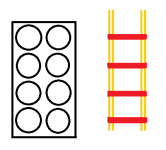OK, tried with the riba welder. No luck with the brass. It came close but didn't really stick. I could tell I was getting good weld current by the way the cables jump. My riba welder has beefed up source connections and freewheel diode. My supply battery is still a bit on the small side, a 35Ahr AGM battery, but it was fresh and fully charged.
I also tried welding some .15mm nickel to the brass. This worked pretty well on the highest setting. On the end cell groups where you want a hefty parallel connection, this may be a good alternative to soldering copper wire.
I'm starting to think if you have enough current to weld the brass properly, you will be risking blowing holes in the cells.
I also tried welding some .15mm nickel to the brass. This worked pretty well on the highest setting. On the end cell groups where you want a hefty parallel connection, this may be a good alternative to soldering copper wire.
I'm starting to think if you have enough current to weld the brass properly, you will be risking blowing holes in the cells.



